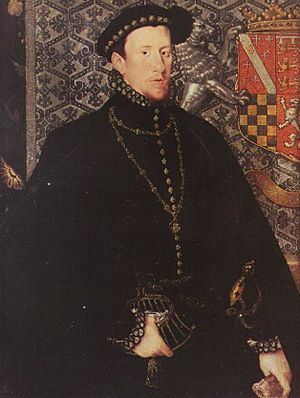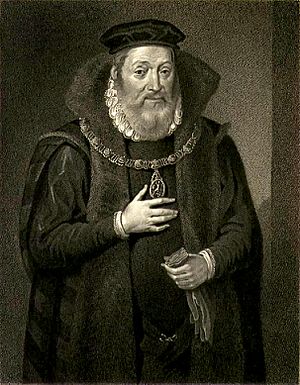Treaty of Berwick (1560) facts for kids
The Treaty of Berwick was an important agreement signed on February 27, 1560, in Berwick-upon-Tweed. It was a deal made between Queen Elizabeth I of England's representative, the Duke of Norfolk, and a group of Scottish nobles called the Lords of the Congregation. The main goal was to get English help to remove French soldiers from Scotland. These French troops were supporting Mary of Guise, who was ruling Scotland for her young daughter, Mary, Queen of Scots. The Scottish nobles also wanted to bring about the Scottish Reformation, which was a big change in religion. This led to a lot of fighting and unrest.
Contents
What Was the Treaty of Berwick?
The Treaty of Berwick was a formal agreement. It set out the conditions for England to send its army and navy to Scotland. The Scottish nobles, known as the Lords of the Congregation, wanted to push out the French influence. They also wanted to change Scotland's official religion from Catholicism to Protestantism.
Who Signed the Treaty?
The main leader of the Scottish Lords of the Congregation was the Duke of Chatelherault. He had once been the ruler of Scotland (called a Regent). At the time of the treaty, he was considered the next in line to the Scottish throne after Mary, Queen of Scots.
His representatives who signed the treaty at Berwick included:
- James Stewart, 1st Earl of Moray
- Patrick, Lord Ruthven
- Sir John Maxwell of Terregles
- William Maitland
- John Wishart of Pitarrow
- Master Henry Balnaves of Halhill
England's representative was Thomas, Duke of Norfolk. The English ambassador in France, Nicholas Throckmorton, encouraged Queen Elizabeth to help the Scottish lords. He believed it would benefit England and create a strong friendship with Scotland, breaking its old ties with France.
Why Was English Help Needed?
The Scottish Lords were fighting against the French soldiers in Scotland. These soldiers were there to protect Mary of Guise's rule. Queen Elizabeth of England was worried about France's growing power. She feared France might try to take over Scotland and then threaten England.
On March 24, 1560, Queen Elizabeth made a public statement. She explained her concerns about Mary, Queen of Scots, using English royal symbols. She also worried about the plans of the powerful Guise family in France. Elizabeth made it clear that England was not at war with France or Scotland. However, she had to prepare her forces "at great cost."
What Happened After the Treaty?
The Treaty of Berwick worked as planned. The English navy already had ships in the Firth of Forth, led by William Winter. After the treaty, an English army, led by Baron Grey de Wilton, marched north from Berwick into Scotland. They camped at Halidon Hill on March 27.
The Scottish Lords met the English army on March 31, 1560, at Aitchison's Haven in East Lothian.
The Siege of Leith
The English forces helped the Scottish Lords in the Siege of Leith. This was a long fight to capture the town of Leith, where many French soldiers were based. The fighting ended in July 1560. This happened after Mary of Guise died and the Treaty of Edinburgh was signed.
Under the terms of the Treaty of Edinburgh, the French forts at Leith, Dunbar Castle, and Eyemouth were torn down. Both the French and English soldiers then went home.
The Scottish Reformation
The religious goals of the Scottish Lords came true in August 1560. This was when the Reformation Parliament met. This parliament also officially approved the Treaty of Berwick. William Maitland praised the treaty. He thanked Queen Elizabeth for her kindness and help in saving Scotland from "almost utter ruin." An English observer, Thomas Randolph, said that everyone agreed, and some would have gladly signed the treaty with their own blood.
Key Points of the Treaty
The articles, or main points, of the Treaty of Berwick were signed on February 27, 1560. Mary of Guise, who was ruling Scotland, wrote to her brothers that she had never seen anything so shameful as these articles.
Some of the important points included:
- Queen Elizabeth believed France wanted to conquer Scotland. She offered to protect Scottish nobles while Mary, Queen of Scots, was married to Francis II of France.
- Elizabeth would quickly send an army to join the Scots.
- Any forts captured by the English would be immediately destroyed by the Scots or given to the Duke of Châtellerault.
- The Scots would help the English Army.
- Any enemies of England would also be enemies of Scotland.
- Scotland would not be connected to France any more than through Mary's marriage.
- Scotland would help England if France tried to invade England.
- The Earl of Argyll would help England rule in northern Ireland.
- The Scots would give "hostages" or "pledges." These were important people sent to England to show the Scots would keep their promises.
The Hostages
The hostages sent in April 1560 included:
- Claud Hamilton, 1st Lord Paisley, the Duke of Châtellerault's son, aged 14.
- Master Alexander Campbell, a cousin of the Earl of Argyll.
- Master Robert Douglas, half-brother of Lord James.
- Master James Cunningham, son of the Earl of Glencairn.
- Master George Graham, son of the Earl of Menteith, aged 5.
- Master Archibald Ruthven, son of Lord Ruthven, aged 14.
These hostages were in Newcastle by April 10, 1560. The Duke of Châtellerault asked Queen Elizabeth to send them home on December 21, 1561. They were meant to stay in England only until a year after Mary's marriage to the French king ended.
The treaty was officially signed and sealed by 30 of the Lords of the Congregation at their camp near Leith (Pilrig) on May 10, 1560. The treaty stated that no loyalty was being taken away from Mary, Queen of Scots, or the French king.



